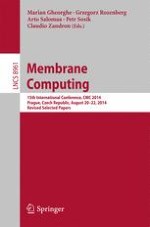This book constitutes the thoroughly refereed post-conference proceedings of the 15th International Conference on Membrane Computing, CMC 2014, held in Prague, Czech Republic, in August 2014. The 19 revised selected papers presented together with 5 invited lectures were carefully reviewed and selected from 24 papers presented at the conference. In addition, two papers selected from the 22 papers presented at the regional version of CMC, the Asian Conference on Membrane Computing , ACMC 2014, held in Coimbatore, India, are included. The papers cover a wide range of topics in the area of membrane computing, which is an area of computer science aiming to abstract computing ideas and models from the structure and the functioning of living cells, as well as from the way the cells are organized in tissues or higher order structures.
